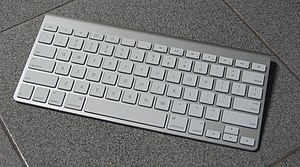Clear key

Pre-2011 Apple Wireless Keyboard (A1314)
|
|
| Developer | Apple Inc |
|---|---|
| Type | Keyboard |
| Release date | 1983 to present |
| Introductory price | Varies |
| Discontinued | Varies |
| CPU | Varies |
| Website | www |
The Apple Keyboard is a keyboard designed by Apple Inc. first for the Apple line, then the Macintosh line of computers. Dozens of models have been released over time, including the Apple Extended Keyboard. There are currently two keyboards offered by Apple: a full-sized version using USB, and the Apple Magic Keyboard, which connects via Bluetooth and omits the numeric keypad of the full-sized model.
Both share a similar look and feel, based on a very thin aluminum chassis and laptop-style low-profile keys, sitting much closer to the tabletop than traditional keyboard designs.
To serve the functionality of the Macintosh operating systems (and because of historical differences), the Apple Keyboard's layout differs somewhat from that of the ubiquitous IBM PC keyboard, mainly in its modifier and special keys. Some of these keys have unique symbols defined in the Unicode block Miscellaneous Technical. Features different from other keyboards include:
The Macintosh keyboards are somewhat reminiscent of the keyboards used for the Apple II.
Apple's very first offering, the Apple I, was initially sold as a naked PCB without a keyboard (or a case), although some resellers and users fitted their own cases with built-in keyboards and Apple cooperated with at least one such reseller.
Starting in 1977, the first real Apple keyboards were built into the cases of the Apple II series and the later Apple III series systems. These first keyboards had chocolate brown keycaps with white legends. The Apple II and Apple II+ keyboard had 52 keys, the Apple III keyboard, which included a numeric pad and some other additional keys, had 74. In 1983, the new Apple IIe and Apple III+ models introduced a beige keyboard with smaller black legends. In the same year, Apple introduced its first separate keyboard with the Lisa; it incorporated a numeric keypad and lighter taupe-colored keycaps. It connected via a unique TRS port. The Macintosh updated the look somewhat and separated the (optional) numerical keypad from the alphanumeric unit, all of which connected by telephone-style modular cables. By 1986, the Macintosh Plus re-integrated the numerical keypad and became the standard for all successive keyboards. However, it also marked the last of the beige Apple-II-era designs which were usurped by the newer Snow White design language.
...
Wikipedia
